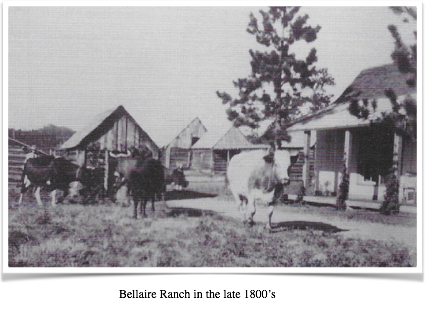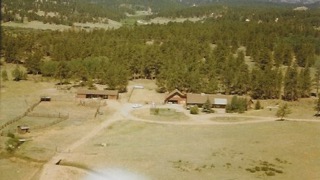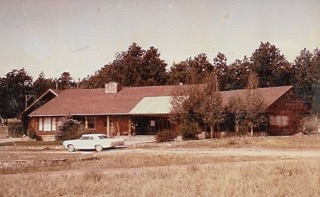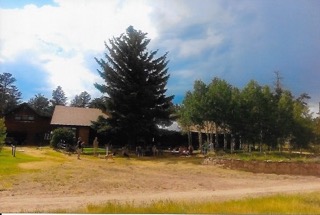History of the Swanson Ranch
by Kathryn Swanson
From the front range plains and the little town of Livermore, Colorado, to the mountain village called Red Feather Lakes is a pleasant 24 mile drive on a smooth paved road. Coming over the crest of McNey Hill you catch the first glimpse of the spectacular Mummy Range in the distance, and you keep climbing as you drive past meadows and cabins and thick forests of pine. “The curving road continues to climb and just above eight thousand feet (you) pass Parvin Lake on (your) right before turning westward. Here, for a mile or more, the road overlooks the beautiful little valley of South Lone Pine Creek.” (1)
Nestled in that “beautiful little valley” is the 500 acre Swanson Ranch of today. Tucked into the hillsides within the ranch are two pioneer cabin sites that most likely were the homes of the earliest white settlers in the Red Feather area. One site overlooking a “second valley” has the remains of a sturdy one room cabin made of huge logs, and also the remains of an outbuilding or shed. Another site in a “third valley” near the Crane Draw has no logs remaining, but clearly was the location of a home, and some indications of a well or storm cellar or potato cellar nearby, all protected by huge granite rocks and set in a grove of aspen and pine.
The ranch also was the site of one of the many locations of the little log school house (which was moved around to meet the needs of the families attending). Up near the current ranch home, one small log building is still standing which may have been a post office before it was a chicken house. But the outstanding feature of this ranch is the South Lone Pine Creek running through it from West to East. Fed by the snows and springs of the Bald Mountains that help sustain life in the pastures below, it continues on through the Swanson ranch and the neighboring ranch to Parvin Lake.
Though the history of the ranch is not entirely clear it is believed to have been the seasonal hunting grounds of the Ute Indians before any white settlers arrived. Soon beaver trappers and fur traders and men seeking gold “in them thar hills” came and went around the whole mountain area. When the settlers moved in, the trappers, traders and Indians moved on to other locations.
In 1861 the city of Fort Collins didn’t yet exist (it was still just a military fort), and Livermore and Virginia Dale were stage stations along the road from Denver to Wyoming. Early pioneers staked claims around the little town of LaPorte; in the Pleasant Valley near the Poudre River; in the area around Livermore near the Lone Pine Creek and Rabbit Creek. These hardy folk started raising cattle on their allotments.
One of these pioneer ranchers was John Hardin, known for the first permanent settlement in Red Feather. He had settled first in Pleasant Valley near LaPorte in 1864 but his wife died of tuberculosis that summer and she was buried in the Bingham Hill Cemetery. Hardin was left with four young children and went back to his former home in Missouri where he found his second wife—a young woman only six years older than his oldest child. He married and came back to Colorado. He decided to move up the mountain to be near the pine trees that were so much in demand by the new settlers in the region. In 1871 he built a cabin on what is now the Bogusky Ranch (at one time the Ben Scott place, later the Mapelli’s. then the Roths, then the McMorris’s and eventually the Monfort place—now in 2009 belonging to Alex and Ana Bogusky).
From his homestead up in that beautiful valley of the South Lone Pine, John Hardin developed a thriving business, logging and taking the logs by horse and wagon down to LaPorte. According to several accounts, John Hardin was the first permanent settler in what is now the village of Red Feather Lakes. Besides logging, Hardin was involved in freighting, a short-lived toll road through his property and a thriving but small English breed cattle business. Old records suggest that the Hardin family continued ranching and “marketing grass-fat cattle of outstanding quality” after John Hardin’s death and until the ranch was sold to Ben Scott in 1931.
Shortly after John Hardin had homesteaded on the South Lone Pine, the Sloan Family came west. Sam Sloan along with his parents, William H. and Martha Sloan, were farming near Leavenworth, Kansas, when they got the urge to move to Colorado, where many of their friends were settling. Sam’s brother Will came too, as did his sisters Ann, Belle, Ollie and Rosa (all of whom eventually married ranchers!) The Sloans arrived in the area on June 4, 1880.
On August 7, 1880, William Sloan bought a ranch near Westlake (now known as Red Feather Lakes) on what is now the Swanson place. Here they homesteaded on what they called Squaw Ranch (also called Squaw Rock Ranch) named after the rock formation that appears to be a Native American woman carrying her babe on her back. The Sloans were neighbors and close friends of the Hardin family, who at that time were on the present-day Bogusky Ranch. Sadly on December 6, 1880, William Sloan was killed when a tree he was cutting fell on him. He was the first person to be buried in the Adams Cemetery on the Red Feather Lakes Road. Mrs. Sloan and the boys continued to ranch there for a while, but eventually moved on to join other Sloans who had settled on Prairie Divide and North Rabbit Creek.
In 1890 Malcolm & Bertha Bellairs began the operation of a cattle ranch in the Westlake area, on what had been the William Sloan place, enlarging the ranch by acquiring the Tom Halliday, McCarthy, Crane and Jocelyn Bellairs homesteads. (One of the valleys on the ranch is still known as the “Crane Draw.”) The Bellairs traded their ranch—with 350 head of cattle on it—to William Dunn Ramer and Charles Ramer in 1910. In 1918 the Ramers sold the ranch to John Laycock and a year later it was traded to John and Amanda Wagner. But John Laycock continued to operate the ranch from 1917 to 1920. The ranch home, which is still used today, was built in 1917, probably by the Wagners.
 R.V. and Melba Barker were the next owners of the ranch, and Gene Barker who is well known as a Red Feather business man grew up on the that land. The ranch was sold sometime in the 1950’s to Greg Rath—a local “cowboy” and his wife K.G. (or “Kagy”) who was “a socialite from back east” or so the story goes. In 1955 the Raths “added on” to the house, nearly doubling its size and modernizing the whole place, building a swimming pool in the back yard and providing a temperature controlled “peacock room” for Kagy’s beloved peacocks. (The swimming pool no longer exists, and now there are no peacocks on the ranch.)
R.V. and Melba Barker were the next owners of the ranch, and Gene Barker who is well known as a Red Feather business man grew up on the that land. The ranch was sold sometime in the 1950’s to Greg Rath—a local “cowboy” and his wife K.G. (or “Kagy”) who was “a socialite from back east” or so the story goes. In 1955 the Raths “added on” to the house, nearly doubling its size and modernizing the whole place, building a swimming pool in the back yard and providing a temperature controlled “peacock room” for Kagy’s beloved peacocks. (The swimming pool no longer exists, and now there are no peacocks on the ranch.)
Skipping back in history to the story of how the Swansons came to Red Feather and eventually became the owners of the ranch: It was 1940 and the United States, although not yet involved in WW II, was already experiencing rationing of products such as gas, sugar, coffee, and nylons. Gas rationing meant that a family looking to take a vacation could only go 500 miles from home. Ralph and May Swanson, born and raised in Omaha, Nebraska, were used to taking a long trip every summer to show their children, Byron and Ellie, around the country and hopefully escape some of the heat and humidity of the Midwest.
But gas rationing dictated 500 mile trips and it just happened that Omaha was situated about 500 miles from Red Feather Lakes. Ralph had developed asthma and a friend in his Kiwanis Club in Nebraska told him of their favorite little vacation spot in the Colorado Rockies where they had a cabin—it was high and dry and very good for asthma. May and Ellie and Byron envisioned something like Estes Park, with movies and restaurants and ice cream and taffy and stores and a library, but Ralph fell in love with Red Feather and it’s peaceful, pristine, undeveloped, non-commercialized atmosphere.
Much to his family’s dismay, he purchased a little cabin near Hiawatha Lake behind the Higley’s home and the community well. Byron remembers having to go down to the well daily for water—and carry it back up the hill to the cabin. But Ralph was happy as a lark with the idea of being in the mountains where he felt good, and he set about adding on to the little cabin, bringing up a generator so they could have a few electric lights (which most places didn’t have in the early ‘40s,) putting knotty pine on the “pressed board” walls, and in general trying to make the place more appealing to the rest of the family. Ellie was 12 going on 13, and Byron was 10 years old, and family history does not record that they were very happy by this new adventure in their lives.
When the war ended, Ralph, ever the optimist and visionary, saw an opportunity to realize a long held dream of his to acquire some land and hopefully have a horse or two. The sand green golf course in Red Feather had gone bankrupt during the war, and the clubhouse had been torn down for the materials in it. So he sold the cabin on the hill, and for the same amount he got for that fixed up little cabin, Ralph bought the 90 acres that held the defunct golf course, and the foundation of the torn-down clubhouse.
All that was left of the clubhouse, beside the foundation, was a large and beautiful moss rock fireplace. The next year, with the help of his driver from his fuel oil business in Omaha, Ralph and Byron logged standing dead timber (allowed in the forests around Red Feather at that time). They began building a log cabin on the old foundation around the fireplace. Ralph and May were able to spend the whole summer in Red Feather because, of course, “no one in Omaha needed fuel oil in the summer!” Ralph’s friends from Omaha, several of whom had cabins in Red Feather, had very handy skills and helped him with plumbing, electricity, and sheet metal work. The result: a very nice cabin on the road—actually on the foundation where the Red Feather Lodge now stands, between the Red Feather Super and the Sportsman’s Café (neither of which were there at that time.)
Ralph reasoned that he didn’t need all 90 acres for the horses he hoped to get, so decided to sell 10 one-acre lots up in the trees to anyone interested in a mountain cabin with a good view and dry, clean air. Now that the war was over, people were beginning to want vacation homes in the mountains and the lots were quickly sold. With that money, he was able to finish the house, and fence the land. The next project was to get a couple of horses. Ralph bought two, down on the Poudre River, and he and Byron were going to ride them back up Pingree Hill. Trouble is, the horses were not “broken” and Byron—a city boy, used to a bicycle and with no horse experience, was nearly “done in.”
Perhaps that would have been the Swanson’s summer place for years to come, but after a few years, May became hugely discouraged with all the dust that drifted into the cabin from the growing traffic on the gravel road in front of the house and they decided to have a new cabin built back away from the road, in the trees and with a good view of the Mummy’s. Ralph was getting ready to retire and sell his business in Omaha and the new cabin project appealed to both of them. They sold the cabin on the road, and at about the same time, they sold some land on the edge of their property across from Snake Lake to Jane and Owen Fender for a restaurant—and the “High Country” was born.
Once again the family felt that everything was fine—a cozy cabin with a Colorado flagstone fireplace away from the dust of the road, a pasture for their horses (now a herd of 6) and a pond where the horses could get water, a good restaurant “around the corner” and two more near-by, a new Chapel in the Pines which Ralph had helped to start, a small library in the community building, a couple of stores/gift shops, and still a rather quiet little mountain village. Then in 1964 there came a severe drought. Ralph knew that the horses could not survive the winter on the 80 acres, as they had in previous years, if the pond dried up and the grass was gone.
So he went down to Greg Rath’s ranch across the road to ask if he could rent the pasture for the winter for the horses. Greg blurted out that he and K.G. had had an argument, were going to get a divorce and were going to sell the place. After expressing his sympathy and getting over the startling news, Ralph asked how much he wanted for the ranch. Ralph was the first to hear of the impending sale, and immediately went to see his old friend, Ted Dunning–“Mr. Red Feather”: the postmaster, store owner, and a real estate broker. Together Ted and Ralph went back to see Greg who indeed was selling his ranch which turned out to be both ranches: the one he lived on AND the “Ben Scott place” as well. Wisely, Ted counseled that the Swansons didn’t need two ranches, so after dividing off six 2.5 acre lots by the road overlooking Parvin which he sold, he then sold the 80 acres and the cabin, sold the second ranch to Sonny Mapelli, and made the present day Swanson Ranch their summer home.

At the same time, Reuben Swanson who was Ralph & May’s pastor in Omaha, collapsed one Sunday in the pulpit as he was preaching. Ralph, who was an active member of that church told Reuben he would give him an acre of land if he would build a cabin on it, take some long vacations and get some rest. So Reuben and Darlene Swanson, who were not related to Ralph and May, but were dear friends, did build a cabin on the ranch and handily, the two families share the “Swanson” sign over the gate. A few years later, Reuben bought 40 acres from Ralph and May adjoining their own cabin to protect their place and to provide an “endowment” to help Ralph & May’s family keep up the ranch.
The ranch is a beautiful and cherished gift from Ralph & May to their children and grandchildren and generations to come. Byron, a college professor, and his wife Kathryn, a high school art teacher, were able to spend time every summer (except one) in Red Feather since they were married in 1956. Their four children, Kim, Tim, Todd, and Brad grew up spending time each summer on the ranch and Grandpa Ralph let them each breed one of his mares down at the old Beckstead Ranch (which is now the Stuart Maxwell Ranch). Consequently after they grew up, finished college, and started their careers each one of them settled eventually on the front range of Colorado with their own families to be close to family and to the ranch.

The Swanson Ranch is now in a Conservation Easement so it will remain undeveloped—a long lasting treasure to be enjoyed by future Swanson generations, and a wide open valley to help keep Red Feather the beautiful place that it is. The Swanson Ranch is a real treasure for the entire family.
